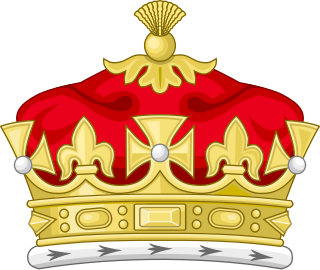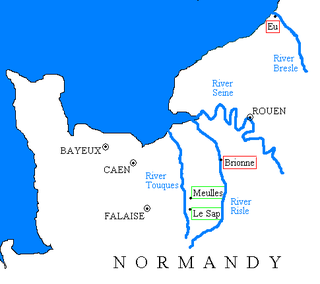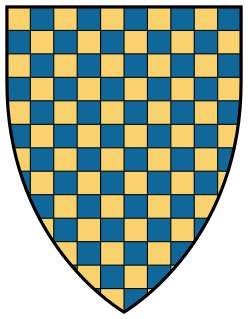Related Research Articles

Duke of Clarence is a substantive title which has been traditionally awarded to junior members of the British Royal Family. All three creations were in the Peerage of England.

William de Redvers, 5th Earl of Devon, of Tiverton Castle and Plympton Castle, both in Devon, was feudal baron of Plympton in Devon.
The Barony of Westmorland also known as North Westmorland, the Barony of Appleby, Appleshire or the Bottom of Westmorland, was one of two baronies making up the English historical county of Westmorland, the other being the Barony of Kendal. Geographically, the barony covered the northern part of the larger county of the same name, and was divided into two wards – East Ward and West Ward. It covered an area similar to that of the Eden District of the new county of Cumbria, although it did not include Penrith, which is now the administrative capital of the district.

Burgh by Sands is a village and civil parish in the City of Carlisle district of Cumbria, England, situated near the Solway Firth. The parish includes the village of Burgh by Sands along with Longburgh, Dykesfield, Boustead Hill, Moorhouse and Thurstonfield. It is notable as the site of the first recorded North African (Moorish) military unit in Roman Britain, garrisoning the frontier fort of Aballava on Hadrian's Wall in the 3rd century AD. It is also where Edward I of England died in 1307.
Hugh de Morville of Appleby in Westmorland, England, hereditary Constable of Scotland, was a Norman knight who made his fortune in the service of David FitzMalcolm (d.1153), Prince of the Cumbrians, later King of Scotland.

Baldwin FitzGilbert was a Norman magnate and one of the 52 Devon Domesday Book tenants-in-chief of King William the Conqueror, of whom he held the largest fiefdom in Devon, comprising 176 holdings or manors. He was feudal baron of Okehampton, seated at Okehampton Castle in Devon.
Ranulf le Meschin, 3rd Earl of Chester (1070−1129) was a Norman magnate based in northern and central England. Originating in Bessin in Normandy, Ranulf made his career in England thanks to his kinship with Hugh d'Avranches - the Earl of Chester, the patronage of kings William II Rufus and Henry I Beauclerc, and his marriage to Lucy, heiress of the Bolingbroke-Spalding estates in Lincolnshire.
Lucy of Bolingbroke or Lucia Thoroldsdottir of Lincoln was an Anglo-Norman heiress in central England and, later in life, countess of Chester. Probably related to the old English earls of Mercia, she came to possess extensive lands in Lincolnshire which she passed on to her husbands and sons. She was a notable religious patron, founding or co-founding two small religious houses and endowing several with lands and churches.

Mulgrave Castle refers to one of three structures on the same property in Lythe, near Whitby, North Yorkshire, England. One of these, known as the "old" or "ancient" castle, was by legend founded by Wada, a 6th-century ruler of Hälsingland. The second castle, caput of the feudal barony of Mulgrave, was of Norman construction and remained active until destroyed by order of Parliament in 1647. The third is a country house which was constructed by Lady Catherine Darnley and passed in 1718 by marriage into the Phipps family, when her daughter Lady Catherine Annesley married William Phipps. The Phipps family later held the titles of Baron Mulgrave, Earl of Mulgrave and Marquess of Normanby.

Grinsdale is a village and former civil parish, now in the civil parish of Beaumont, in the Carlisle district, in the English county of Cumbria. Grinsdale has a church called St Kentigern's Church. It is the source of the surname. It is also beside the River Eden. The civil parish was merged into Beaumont in 1934. In 1931 the civil parish had a population of 161.

In the kingdom of England, a feudal barony or barony by tenure was the highest degree of feudal land tenure, namely per baroniam, under which the land-holder owed the service of being one of the king's barons. The duties owed by and the privileges granted to feudal barons are not exactly defined, but they involved the duty of providing soldiers to the royal feudal army on demand by the king, and the privilege of attendance at the king's feudal court, the precursor of parliament.

The House of Braose was a prominent family of Anglo-Norman nobles originating in Briouze, near Argentan, Orne, Normandy. Members of this family played a significant part in the Norman conquest of England and subsequent power struggles in England, Wales and Ireland in the 11th to 14th centuries.
William Meschin was an Anglo-Norman nobleman and baron. The brother of the earl of Chester, Meschin participated in the First Crusade. After returning to England, he acquired lands both from King Henry I of England and by his marriage to an heiress.
The feudal barony of Gloucester or Honour of Gloucester was one of the largest of the mediaeval English feudal baronies in 1166, comprising 279 knight's fees, or manors. The constituent landholdings were spread over many counties. The location of the caput at Gloucester is not certain as Gloucester Castle appears to have been a royal castle, but it is known that the baronial court was held at Bristol in Gloucestershire.
The feudal barony of Curry Mallet was an English feudal barony with its caput at Curry Mallet Castle in Somerset, about 7 miles east of Taunton.

The feudal barony of Clifford was a feudal barony with its caput baroniae at Clifford Castle in Herefordshire, England.

The feudal barony of Appleby was a feudal barony with its caput at Appleby Castle in Appleby, Westmorland, England.

The de Warenne family were a noble family in England that included the first Earls of Surrey, created by William the Conqueror in 1088 for William de Warenne, 1st Earl of Surrey, who was among his companions at the Battle of Hastings. The family originated in Normandy and as Earls, held land there and throughout England. When the senior male-line ended in the mid-12th century, the descendants of their heiress adopted the Warenne surname and continue as Earls of Surrey for another two centuries. Several junior lines also held land or prominent offices in England and Normandy.

The Constable of Chester was a mediaeval hereditary office held by the Barons of Halton. The functions of the Constable are unclear, possibly they related to the custody of Chester Castle, as was the main function of most mediaeval constables, but Sanders (1960) says the office-holder was constable for the entire County Palatine.
Burgh by Sands Castle was located near the village of Burgh by Sands, Cumbria, England.
References
- ↑ "Cumberland: Directory of Baronies and Superior Manors" . Retrieved 16 July 2015.